300: Rise of an Empire (2014)
based on the graphic novel 'Xerxes' by Frank Miller
| REEL FACE: | REAL FACE: |
Sullivan Stapleton
Born: June 14, 1977 Birthplace: Melbourne, Australia | Themistocles
Born: c. 524 BC Birthplace: Athens, Greece Death: 459 BC, Magnesia on the Maeander (likely of natural causes) |
Eva Green
Born: July 5, 1980 Birthplace: Paris, France | Artemisia I of Caria
Born: 5th Century BC Birthplace: Halicarnassus, Caria, Persia Death: 5th Century BC |
Rodrigo Santoro
Born: August 22, 1975 Birthplace: Petrópolis, Rio de Janeiro, Brazil | Xerxes
Born: 519 BC Birthplace: Persia Death: 465 BC, Persepolis, Persia (assassination by stabbing, likely by his political advisor Artabanus) |
Lena Headey
Born: October 3, 1973 Birthplace: Hamilton, Bermuda | Queen Gorgo
Born: c. 513 BC Birthplace: Sparta, Greece Though not Gorgo, this unidentified Spartan artifact from that period reflects how she would have presented herself. |
Immortals (300: Rise of an Empire Movie)
The Persian Imperial soldiers in the movie, inspired by Frank Miller's graphic novel '300' and his follow-up 'Xerxes.' | Immortals (Persian History)
The Immortals were an Imperial Guard division that protected the Persian rulers during the time of the Greco-Persian Wars. |
Did Artemisia really have a hunger for warfare?
Yes. Herodotus, also known as the "Father of History," makes numerous references to Artemisia as he recounts the events of the Greco-Persian war. He describes her as a ruler who did not lead passively, and instead, actively engaged herself in both adventure and warfare. "…her brave spirit and manly daring sent her forth to the war, when no need required her to adventure. Her name, as I said, was Artemisia..." -The Histories
Was Artemisia really known for her cunning tactics and intelligence in combat?
Yes. In exploring the 300: Rise of an Empire true story, we came upon the works of Polyaenus, the 2nd century Macedonian writer. He describes an example of the real Artemisia's intelligence in combat. He tells of how she would carry two flags on board her ship, one a Persian flag and the other the flag of her enemy, Greece. Artemisia would fly the Greek flag as she approached an unsuspecting Greek warship. Once she was upon her enemy, she would then unleash the full force of her Carian fleet.
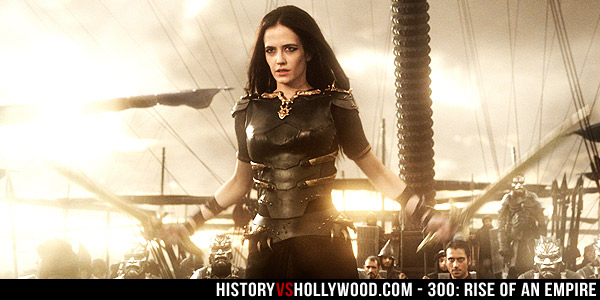
Similar to Artemisia (Eva Green) in the 300: Rise of an Empire movie, the real Artemisia, Queen of Caria, was a cunning conqueror with a penchant for warfare.
In another example described by Polyaenus, Artemisia prepared a great festival to be held approximately a kilometer away from the ancient city of Latmus, which she planned to conquer. The festival drew the attention of the nearby city, and both civilians and soldiers left the city to see what the fuss was all about. After the city emptied itself, Artemisia launched a full-scale invasion, conquering Latmus with little resistance.
Were the Greeks really angered that a woman had taken up arms against them?
Yes. According to Herodotus, the united Greeks even offered a reward of 10,000 drachmas for Artemisia's capture.
What do the events in 300: Rise of an Empire have to do with the events in the original movie 300?
300: Rise of an Empire is a prequel, a side-sequel, and a sequel to the original film, 300 (2007), with the events in the follow-up taking place before, during, and after the events in the original. The first battle that takes place in the 300: Rise of an Empire movie is the Battle of Marathon in 490 BC. This happens ten years prior to the events in 2007's 300 movie. Athens victory over Persia at Marathon, Greece sets the stage for the motivations behind Xerxes's transformation into the movie's fictional God King.
The second battle that occurs in 300: Rise of an Empire, the Battle of Artemisium (a 480 BC naval engagement), took place concurrently with the Battle of Thermopylae that unfolds in the original movie, 300. It was Themistocles who proposed that the Greeks attempt to stop the Persian advance by confronting them on land at the narrow strait at Thermopylae. Leonidas and the 300 Spartans undertook the task, which is chronicled in the movie 300, with the Spartans eventually being overtaken by the Persian forces. At the same time, the Greek navy attempted to block the Persians on the water in the Straits of Artemisium. However, they were forced to retreat after the defeat at Thermopylae.
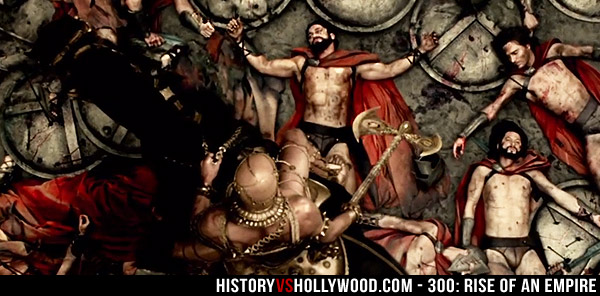
Persian king Xerxes (Rodrigo Santoro), with ax in hand, sits atop his horse as he looks over his fallen enemy, the Spartan king Leonidas (Gerard Butler). From 300: Rise of an Empire.
The third battle in Rise of an Empire, the Battle of Salamis, occurs after the Persians have advanced and burned Athens to the ground. Like in the movie, Themistocles had learned from the mistakes he made in the Battle of Artemisium, realizing that Greece likely did not stand a chance when confronting the larger Persian navy in the open water. He figured out that if the Greeks were to win, they would need to engage in close combat with the Persians in straits that were more narrow, such as those at Salamis. There, the large Persian warships could be outmaneuvered by the smaller Greek ships.
Had the Athenian general Themistocles been born into poverty?
Yes. According to historians Herodotus and Plutarch, the brave Athenian general Themistocles was not born into wealth. His father, Neocles, was an ambiguous Athenian citizen of modest means. It is believed that his mother was an immigrant. Other children kept Themistocles at a distance. It didn't bother him much, because as other children were off playing together, Themistocles was studying and sharpening his skills. As described by Plutarch, his teachers would say to him, "You, my boy, will be nothing insignificant, but great one way or another, either for good or for evil."
In researching the 300: Rise of an Empire true story, we learned that Themistocles less than modest upbringing benefited him in the newly democratic government of Athens. He campaigned in the streets and could relate to the common and underprivileged in a way that no one had before, always taking time to remember voters' names. He was elected to the highest government office in Athens, Archon Eponymous, by the time he was thirty.
Was Themistocles really responsible for Greece's strong navy?
Yes. Themistocles always believed in building up the Athenian navy. He knew that the Persians could only sustain a land invasion if their navy was able to support it from the coastal waters. However, most Athenians, including the Athenian generals, did not agree with Themistocles. They did not believe that a Persian invasion was imminent, and they thought that the Athenian army was strong enough to make up for any shortcomings with regard to the navy.
To get his wish for a stronger navy, Themistocles used his political position to lie and mislead the Athenians into believing that the rival nearby island of Aegina posed a threat to merchant ships. Accepting his argument, the Athenians decided to invest in the navy, leaving Athens with the most dominant naval force in all of Greece. Therefore, it can be argued that Greek civilization was saved by a lie.
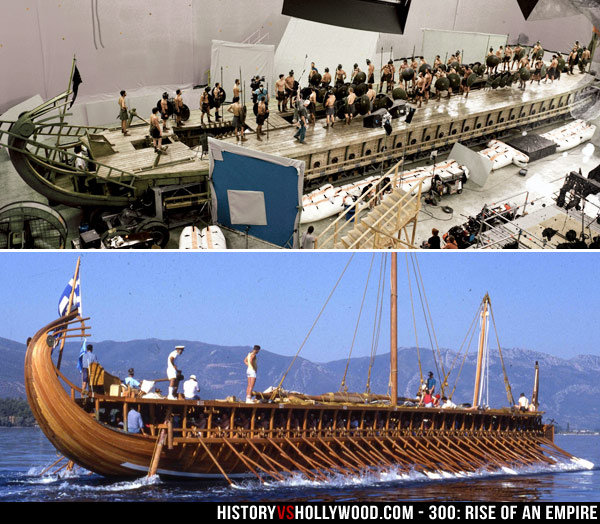
Top: Actors stand on the deck of an Athenian trireme (ancient vessel) constructed on a sound stage for the movie. Bottom: A seaworthy reconstruction of a trireme, the Olympias, was launched in 1987.
Did Themistocles really kill Xerxes's father, King Darius?
No. The true story behind 300: Rise of an Empire reveals that Themistocles did not kill Xerxes's father, King Darius I of Persia (Darius the Great), with an arrow at the Battle of Marathon. King Darius died approximately four years later in 486 BC of failing health. It was then that Xerxes, the eldest son of Darius and Atossa, became King, ruling as Xerxes I.
Did Xerxes really transform into a God King?
No. As you probably guessed, the real Xerxes did not transform into a supernatural God King like in the movie (pictured below). In fact, Xerxes's motivation for his transformation did not even exist in real life, since Themistocles did not kill Xerxes's father at the Battle of Marathon. This highly fictionalized version of Xerxes comes from the mind of Frank Miller, the creator of the 300 graphic novel and the still unpublished Xerxes comic series.
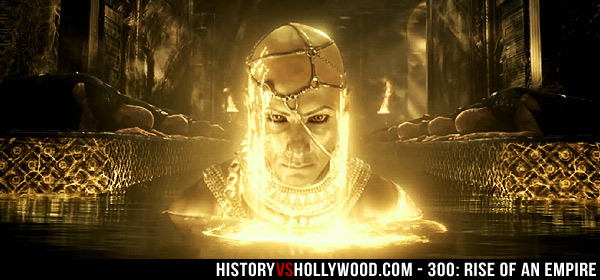
Persian king Xerxes (Rodrigo Santoro) transforms into the fictional God King in 300: Rise of an Empire.
Was Artemisia's family murdered by Greek hoplites, after which she was taken as a slave?
No. In the 300: Rise of an Empire movie, a young Artemisia (Caitlin Carmichael) watches as her family is murdered by a squad of Greek hoplites. She then spends several years being held as a sex slave in the bowels of a Greek slave ship. She is left to die in the street and is helped by a Persian warrior. She soon finds herself training with the finest warriors in the Persian Empire, hoping to one day exact revenge on Greece. This backstory for Artemisia was invented by Frank Miller and the filmmakers to explain the motivations behind Artemisia's ruthless thirst for vengeance in the film.
Did Artemisia have a husband?
Yes. Queen Artemisia of Caria, portrayed by Eva Green in the movie, became queen when she was wed to the King of Caria. Ancient Greek historian Herodotus never mentions the king by name in his writings titled The Histories. Little is known about Artemisia's husband except that he died when their son was still a boy. Following his death, Artemisia became the ruler of the affluent kingdom of Caria.
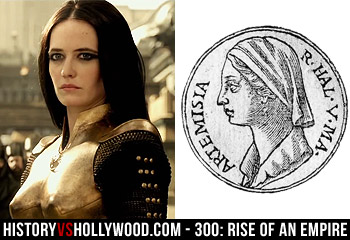
Left: Artemisia (Eva Green) clad in armor in 300: Rise of an Empire. Right: A 16th century coin-like portrait of Artemisia from Guillaume Rouillé's book Promptuarii Iconum Insigniorum.Did Artemisia have any children?

Left: Artemisia (Eva Green) clad in armor in 300: Rise of an Empire. Right: A 16th century coin-like portrait of Artemisia from Guillaume Rouillé's book Promptuarii Iconum Insigniorum.
Yes. Artemisia I of Caria had a son named Pisindelis (not shown in the movie), who was still a boy when his father died and his mother took over as ruler.
Was Artemisia the only female commander in the Greco-Persian wars?
Yes. According to the writings of Herodotus, Artemisia I of Caria was the only female commander in the Greco-Persian wars. Like in the movie, she was an ally of Xerxes and served as a commander in the Persian navy.
Did the Greek city-states really band together against the invading Persian Army?
Yes. In the 300: Rise of an Empire movie, we see Queen Gorgo of Sparta (Lena Headey) and Themistocles of Athens (Sullivan Stapleton) coming together to unite against the Persian Army. In real life, Athens and Sparta were indeed at the forefront of the alliance between the thirty Greek city-states. As the alliance took hold, Themistocles became the most powerful man in Athens.
How were the Persians able to take Athens?
Themistocles had convinced Athens to put every able-bodied man, including the Athenian warriors, on warships to stop the Persians in the Straits of Artemisium, leaving the city of Athens unprotected. Plutarch writes of the evacuation of Athens in his work Themistocles. "When the whole city of Athens were going on board, it afforded a spectacle worthy alike of pity and admiration, to see them thus send away their fathers and children before them, and, unmoved with their cries and tears, passed over into the island."
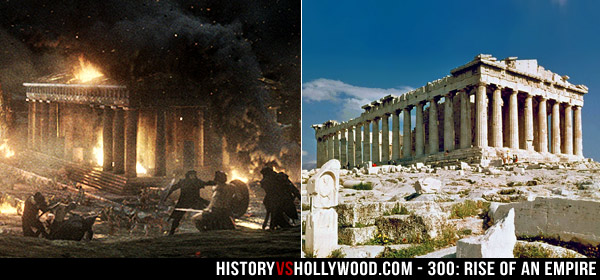
While it appears that the Parthenon (right) is burning in the movie (left), it is actually the Old Parthenon that was destroyed by the Persian forces during the invasion. The iconic Parthenon that we are familiar with was actually built several decades later to replace the Old Parthenon.
Did Themistocles win the Battle of Salamis by luring Xerxes into a trap?
Yes. Themistocles had sent a messenger to Xerxes, telling the Persian King that the Greeks intended to flee by ships that were harbored in the isthmus of Corinth. Unlike in the movie, that messenger was not Ephialtes of Trachis, the disfigured hunchback who had betrayed the Spartans at Thermopylae. The real Ephialtes, who was not a disfigured hunchback, escaped to Thessaly and the Greeks offered a reward for his death.
Thinking that the Greek forces were scattered, weak, and intending to flee, Xerxes believed the messenger and sent in his navy for an easy victory. To his surprise, his ships encountered the full force of the Greek navy ready to engage in battle.
Did Themistocles and Artemisia share a moment of violent, unbridled passion?
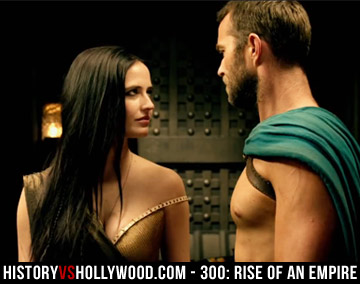
Artemisia (Eva Green) and Themistocles (Sullivan Stapleton) share a fictional moment of passion in 300: Rise of an Empire.
Was Themistocles married?
Yes. In the movie, Themistocles tells Artemisia that his only family is the Greek fleet, which he has spent his entire life readying to battle her. According to the writings of Plutarch, the real Themistocles did have a wife, Archippe, with whom he had three sons: Archeptolis, Polyeuctus, and Cleophantes. He also had two older sons, Neocles and Diocles. In addition to his sons, Themistocles had five daughters that are mentioned by Plutarch, at least one of whom he had later during a second marriage.
Did Xerxes watch the Battle of Salamis as he sat in his throne perched atop a cliff?
Yes. Xerxes watched the battle unfold high atop a nearby cliff on Mount Egaleo. Not shown in the movie, he witnessed Artemisia ramming another ship that had unknowingly crossed her path as she tried to get away from a pursuing Athenian trireme. Xerxes assumed it was an Athenian vessel that she had smashed through and was so impressed with Artemisia's ferocity in battle that he is reported to have said, "My men fight like women, and my women like men!" In reality and unbeknownst to Xerxes, Artemisia had bore straight through an ally ship. In doing so, Artemisia's pursuer gave up chase, believing that she was an ally of the Greeks. Fortunately for Artemisia, the ally ship sunk and its entire crew drowned, leaving no one behind to tell Xerxes the truth. -The Histories
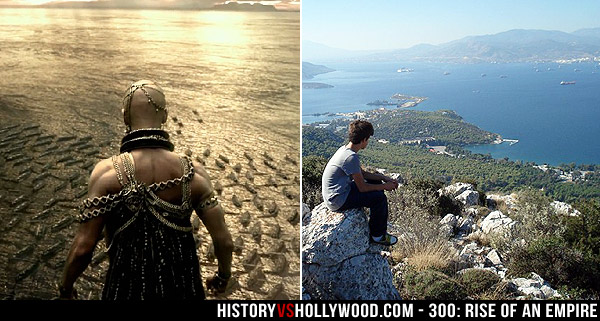
From high atop a cliff, Xerxes (Rodrigo Santoro) overlooks his fleet in the Straits of Salamis in the movie (left). A look from the real Mount Egaleo that overlooks the Straits of Salamis where the battle took place (right).
Did Artemisia agree with Xerxes with regard to the Battle of Salamis?
No. However, unlike in the film where Artemisia (Eva Green) demands that Xerxes order the Persian fleet to Salamis to finish off the Greeks, the real Artemisia had actually advised the Persian King Xerxes against the battle, arguing that it is not wise to engage the Greeks at sea. By this point, Xerxes had already burned the great city of Athens to the ground. Victory was within his grasp and his advisers/officers, except for Artemisia, told him that he must launch a naval assault to finish off the Greeks. Artemisia saw things differently.
"Spare your ships," Artemisia advised, "and do not risk a battle; for these people are as much superior to your people in seamanship, as men to women. What so great need is there for you to incur hazard at sea? Are you not master of Athens, for which you did undertake your expedition? Is not Hellas subject to you? Not a soul now resists your advance…" -The Histories
In the end, though Xerxes respected her advice, he still decided to launch a full-scale naval assault in September, 480 BC. Unfortunately for the Persians, it was the wrong decision and the Battle of Salamis proved to be the turning point in the war. Like in the 300: Rise of an Empire movie, the Persians were outmaneuvered and outfought by a Greek navy that was better prepared to wage war in the narrow straits between the mainland and the island of Salamis (known as the Straits of Salamis).
Did Artemisia die at the Battle of Salamis?
No. The 300: Rise of an Empire true story reveals that unlike what is shown in the movie, the real Artemisia did not die at the hands of Themistocles in the Battle of Salamis. She survived the battle and did not meet her fate while engaging in combat.
While Artemisia I of Caria did not perish in battle, it is unclear how she actually died. One legend reported by Photios, the Ecumenical Patriarch of Constantinople from 858 to 867 and from 877 to 886, has Artemisia falling in love with a man named Dardanus. According to Photios, when Dardanus rejected her, Artemisia threw herself over the rocks of Leucas and was swallowed by the Aegean Sea. However, some historians argue that this action goes against her nature as a strong-willed conqueror.
What happened to Artemisia after the Battle of Salamis?
After being on the losing side of the battle that she had advised the Persian King against, Xerxes once again sought her advice. This time he acted on it, and he returned home, abandoning his campaign.
Artemisia was entrusted with the care of Xerxes's children (the illegitimate sons he had taken on the campaign with him). She accompanied them to the town of Ephesus on the Ionian coast. Despite the Greeks continuing to engage in war for several more years, Artemisia and her people gained favor with the Persian Empire and prospered from the relationship.
Where can I read Frank Miller's graphic novel Xerxes, on which 300: Rise of an Empire is based?
As of the release of the 300: Rise of an Empire movie in March of 2014, Frank Miller had not yet completed his sequel to his 1998 comic series 300. In early 2011, Dark Horse Comics CEO Mike Richardson told ICv2 that Miller had finished two issues but had several Hollywood commitments that were keeping him from finishing the rest. These Hollywood obligations included acting as co-director for Sin City 2, due out in August 2014. The ICv2 article states that Frank Miller has every intention of finishing the Xerxes comic series.
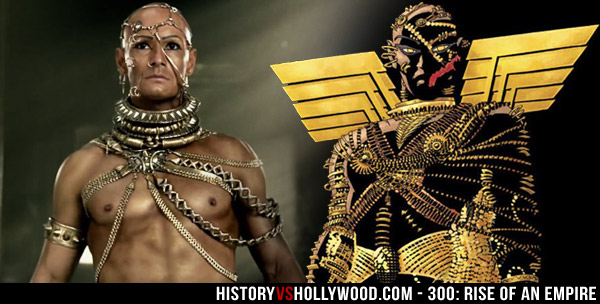
The God King Xerxes (Rodrigo Santoro) in the movie (left) and Xerxes from Frank Miller's unpublished (as of the film's release) graphic novel.
Why didn't director Zack Snyder, who directed the first film, also direct Rise of an Empire?
In 2008, Variety reported that Zack Snyder, who directed 2007's 300 starring Gerard Butler, was interested in directing an adaptation of Frank Miller's follow-up graphic novel Xerxes (the original 300 movie was based on Miller's 1998 graphic novel 300). However, Zack Snyder instead chose to direct the Superman reboot Man of Steel, released in 2013. As a result, Noam Murro was brought in to direct 300: Rise of an Empire with Snyder acting as a producer and co-writer (Deadline Hollywood).
300: Rise of an Empire Movie Trailer & Related Videos
After you've finished reading our analysis of the 300: Rise of an Empire true story vs. the movie via the questions above, enjoy the related videos below, including the Rise of an Empire trailer and videos that provide a closer look at the movie's heroes and villains.
WATCH Meet the Heroes of 300: Rise of an EmpireWatch an introduction to the heroes of
300: Rise of an Empire, including
Themistocles (Sullivan Stapleton), the
Greek general who took on the Persians at
the battles of Marathon, Artemisium and
Salamis. |
WATCH Meet the Villains of 300: Rise of an EmpireLearn about the 300: Rise of an
Empire villains. Catch a glimpse of
the murderous Persian commander Artemisia,
portrayed by Eva Green. Witness the
transformation of Xerxes into a God King
and see other returning villains,
including the Immortals. |
WATCH Eva Green Interview on Playing ArtemisiaActress Eva Green, who portrays naval
commander Artemisia in the movie,
discusses the real Artemisia and other
similar female characters that inspired
her performance, including Cleopatra and
Lady Macbeth. The interviewer asks her
what was harder, preparing for the
tumultuous 300: Rise of an Empire
sex scene or the movie's numerous battle
sequences. |
WATCH 300: Rise of an Empire Trailer 3The sequel to 2007's
300 starring Gerard Butler,
this installment finds Themistocles of
Athens (Sullivan Stapleton) defending
Greece during the second Persian invasion.
This time, Xerxes I of Persia (Rodrigo
Santoro) returns and is joined by
Artemisia I of Caria (Eva Green), who
takes on Greece in the naval engagement
known as the Battle of Artemisium. In
addition to Santoro, Lena Headey returns
to reprise her role as Queen Gorgo of
Sparta. Check out our
research into the original 300
movie. |
Link-to-Learn More:
- 300: History vs. Hollywood (2007)
- Read Herodotus' The Histories Online in Parallel English/Greek Text
- 300: Rise of an Empire Official Warner Bros. Movie Website








